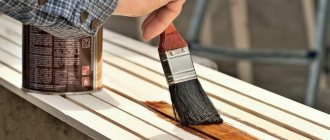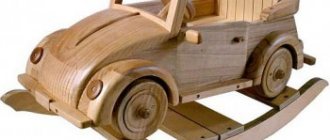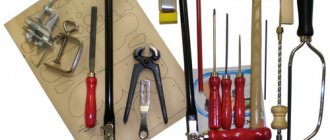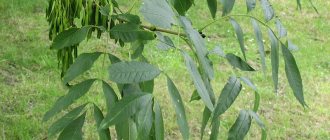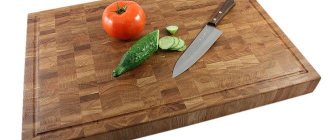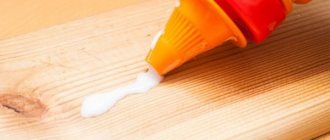Using sandpaper in decoupage. Types of sandpaper and sanding process.
Sandpaper is the material that is almost always specified in any of our decoupage workshops. It would seem that one could write about it, because everything is extremely simple - sandpaper or sandpaper is used to smooth out unevenness and roughness of the surface in order to give it ideal (or close to ideal!) smoothness.
But people who are new to creativity have many different questions about materials and their correct use. Therefore, today we will talk about sandpaper, its types of grit, and how to properly sand different surfaces.
“Sandpaper” differs in grain size and the base on which the abrasive is applied.
• Paper
the base is the most common and cheapest option. It easily breaks into pieces of different sizes, and can be very fine-grained, which is ideal for final sanding. However, this option can be considered a one-time use: tear off a piece, sand it, throw it away. It gets clogged and wears out very quickly.
• Fabric
the base is a much more wear-resistant material. Most often it is impregnated with special resins, which adds moisture-repellent properties to it. After one use, you can rinse it with water, dry it and use it again. It is more plastic, it can be bent and used to sand hard-to-reach places, for example, slots in carved boxes or boards.
• There is also a combined
the base (paper + fabric) is the most expensive “sandpaper”. From fabric she took elasticity and water-repellent properties, and from paper she took the ability to apply the finest abrasive.
There are also useful materials such as:
• sanding stones
— very convenient for sanding large, flat surfaces. Can be washed and reused many times.
• abrasive (grinding) sponges
— ideal for grinding complex, voluminous, spherical, and relief surfaces.
Hand blocks for sanding wood
When processing any board, you can rub sandpaper over the surface. There will be some result. Only your hand will get tired quite quickly, and the abrasive will heat up and become uncomfortable to hold.
For fixation, many people use a regular block. They wrap it around a piece of sandpaper. This is enough to do the simplest work. However, real craftsmen make more convenient devices (Fig. 1).
The grinding block is made in the following sequence.
- Two wedge grooves are sawn into a hardwood board. 2.
- Pairs of wedges are also made. 3.
- Cut the skin to a suitable length so that the ends fit into the wedge grooves.
- Then the skin is fixed in the grooves with wedges.
- The finished sanding block is ready for use.
Rice. 1 Wedge-mounted sanding block
A simpler block can be made using two self-tapping screws and two paper clothespins (Fig. 2).
- Self-tapping screws are screwed in on the non-working part of the block (it is more convenient to use self-tapping screws with a press washer).
- The fastening loop of one of the clothespins is inserted under the head of the screw on one side, the other is installed on the back of the device.
- Cut the sandpaper to such length that it can be secured in clothespins.
- The block is ready. For ease of operation, it is advisable to secure the handle on top.
Rice. 2 Sanding block with self-tapping screws and clothespins
Rice. 3 Sanding block for machining large radius concave surfaces
When working with wood, sometimes you have to process more than just planes. Often, to give an original shape, curved grooves are sawn or a complex shape is given. In order to grind the surface in this case, the pads are made with a curved working surface (Fig. 3 and Fig. 4).
Rice. 4 Sanding block for machining concave surfaces of small radius
If there is a need to obtain a strict angle, then use a corner block (Fig. 5). There is only one work surface on it. The other surface is used to maintain the exact angle. Most often they are made for processing at a right angle (90°), but a similar grinding device can be made at any desired angle.
Rice. 5 Angle sanding block
Peculiarities
Sandpaper when puttying any surface is needed to ensure perfect smoothness and evenness before painting the walls or decorating it with wallpaper. Moreover, if the walls are painted during finishing, then it will be necessary to carry out the most thorough leveling not only with coarse, but also with fine sandpaper. When hanging wallpaper, you can skip this step altogether, with the exception of using glossy types and silk-screen printing.
The use of this material allows you to eliminate strong level differences and achieve the most even surface possible. Regardless of the quality of putty used, various bumps and depressions will still remain on the surface, which can be removed with sandpaper.
Only grinding will allow you to quickly and efficiently achieve the required results.
Release forms and types
Our usual form of release is in rolls or sheets. The sheet can be based on cardboard, or it can be on thick paper. Most often it is more rigid than rolled. Roll sanding is most often used on belt sanding machines, and for manual use too. In addition, there are the following types of abrasive materials:
- Abrasive wheels. Used for installation on attachments for special machines. These can be grinders, drill attachments, angle grinders. There are different types: Regular circles of different diameters and different grain sizes.
- With Velcro glued to the back.
- Petal ones are when strips of sandpaper are glued to the base. Can be of different grain sizes. They are used for rough processing of metals (usually) and for removing paint (including from concrete).
Abrasive sanding paper is available in the form of sheets, rolls, tapes, and wheels. There are other forms - for attachments to instruments
There are also sanding sponges. This is an abrasive that is applied to polyurethane foam. This type of abrasive is used to smooth surfaces with grooves, threads, and recesses. Abrasive particles can be applied to one, two or four sides of the sponge. May be the same size or different. But usually, this is a fine grain, just of varying degrees of “fineness”. Sponges are more convenient because they can take any shape; in addition, they can be washed to remove dust and dried. The number of washes is not limited. They do not suffer from washing; they can be used while the grain is still intact. And this depends on the quality.
Summary
- During “dry” machine grinding, the primer-filler is processed sequentially with P320-P400-P500 abrasives. When working manually “wet”, materials of smaller gradations are used: P600-P800-P1000.
- You cannot treat the surface with an abrasive finer than P600 “dry” and P1000 “wet” - adhesion to the top enamel will be insufficient.
- On curved surfaces, ends and various hard-to-reach places, use Superfine/Ultrafine abrasive sponges.
- During the sanding process, use a development coating - it will make it easier to control the surface.
- The prepared part should stand waiting for painting for no more than a day, otherwise the surface must be re-sanded with a final abrasive.
- In case of partial painting, areas adjacent to the repair area must be matted. Read more here.
Pads and jaws
A block is an extremely useful device for manual grinding; its presence and proper use can speed up the process. The block, as a rule, is a regular wooden block wrapped in sandpaper. Its abrasive side should be on the outside, and the non-abrasive side should be attached to the block with a large stapler or PVA glue. Some hardware stores sell ready-made pads with sandpaper, that is, you don’t have to make it yourself, but just buy it.
Foamed polyurethane sponges are also used for sanding wood. They are more convenient to use than sandpaper, since you can wash them under water after work. Sponges and abrasive cloths are great for careful hand sanding of wood, allowing you to process the smallest details. They can also be used to sand primed or varnished wood.
What is grinding done?
In cutting theory, when determining a tool to perform the process itself, a cutter is considered. It has cutting edges. They introduce the processed material into the body. The sharpening angles determine the features of the cutter's penetration into the material, as well as the formation of chips.
When it comes to the grinding method of processing, here we observe the work of not one cutter, but several at once. Their number is often measured in the thousands. The more small cutters involved in the work at the same time, the higher the quality of the machined surface. The abrasive grains act as cutters - these are grains of sand with a fairly high hardness, glued to paper or fabric.
To classify grinding tools, the concept of the number of grains of 1 square centimeter was introduced. For example, the designation P36 implies that on average there are 36 grains per square cm. If the abrasive is designated P200, then, accordingly, there are on average 200 grains per square cm.
When roughing of a part is required and a fairly thick layer needs to be removed, abrasive materials with a small number of grains are used. As the quality of the processed surface improves, the size of the grains themselves decreases and their number increases.
The table provides recommendations for using abrasive cloths for their intended purpose.
Attention! When using abrasives with a high grain count, rapid clogging occurs. To increase the duration of use, it is recommended to regularly shake off the sandpaper. Then it will have to be replaced less often. Before starting finishing work, an audit of the abrasive material is carried out. Assess the amount of sandpaper available.
Coarse grinding is also performed using hard brushes. They are made from spring wire. Using a similar tool, brushing (artificial aging of wood) is performed.
To sand logs, plastic bristles are used instead of wire. It is made from rigid fishing line with a diameter of 3.0...4.5 mm. To increase productivity, such brushes are made on disks.
Stage of enlightenment No. 1: mesh or sandpaper
The first thing you need to answer for yourself before starting work is which abrasive material do you prefer: mesh or sandpaper ? Yes, yes, sandpaper is not the only way out of the situation, but here’s the best or worst way, let’s try to figure it out:
Mesh Features
Samples of grinding mesh with cells of different sizes.
A distinctive feature of this abrasive material is its perforated structure . That is, in this case, the excess putty is cut off by the sharp edges of the cells, after which it falls through them without clogging the working part itself, as happens with sandpaper, which I will discuss below.
The cells are end-to-end, so they don’t get clogged
But we should immediately note a couple of disadvantages characteristic of using the grid:
- Relatively high price of consumables. This means, of course, in comparison with sandpaper;
- Cannot be used in combination with some electric sanders . Sandpaper is much more versatile in this regard.
Features of sandpaper
Enlarged view of sandpaper surface
Although we are accustomed to using the word “paper,” the base of the sandpaper can also be textile. Moreover, it is these models that are more practical, since the abrasive grain has much better adhesion to fabric than to paper.
Now I want to tell you why I personally, as a rule, still choose sandpaper rather than mesh, despite the fact that it has such an unpleasant property as rapid wear.
This is facilitated by the following qualities present in this material:
The rate of clogging of the abrasive surface with putty waste can also be slowed down. To do this, try to sweep away the dust generated during work from the wall as often as possible with a brush.
- Low cost . It’s quite affordable to stock up on sandpaper even for future use, so as not to run to the shops every time you need it.
Here are examples of prices that you can find in construction stores for the product in question:
- With coarse grain:
| Parameter | Description |
| Roll length | 30 m |
| Roll width | 77.5 cm |
| Marking | 80-N |
| The basis | Fabric |
| Cost of one roll | 5900 rubles |
Sample roll of 80-N sandpaper
- With fine grain:
| Parameter | Description |
| Roll length | 30 m |
| Roll width | 77.5 cm |
| Marking | 10-N |
| The basis | Fabric |
| Cost of one roll | 6490 rubles |
- Versatility , which I already mentioned. The sandpaper is cut in the form of any tape or circle, in any size, after which it can be installed on any electrical grinding equipment;
Sanding belts for belt sander
- Ease of processing hard-to-reach areas . To do this, just bend a piece of sandpaper, which will result in a fairly rigid bend with an abrasive coating, which can be used to sand the corner and get behind the battery. With a grid, this trick simply won’t work;
- High quality results due to the use of models with different grain sizes. There are also meshes with cells of different sizes, but sandpaper is more varied in this matter. This allows you to start with large grains, removing noticeable errors, and finish with the smallest ones, bringing the wall surface to a perfectly smooth state;
Round eccentric blades with different grain sizes
Selection of sandpaper
What is the best way to sand wood? Which sandpapers should you choose for your work? In reality, these are not such simple questions. Sandpaper today is made from different materials:
- pomegranate (very rare);
- silicon carbide;
- ceramics;
- electrocorundum and others.
Garnet is characterized by the fact that it wears down faster than all other materials, but carefully sands wood. And silicon carbide, according to experts, is perfect for sanding the varnish coating and removing particles of debris and dust stuck to it.
Ceramic sandpaper is usually used when sanding wood with sanders. Skins with a ceramic working surface are one of the hardest and most expensive abrasives. Much the same can be said about corundum.
But the most important classification of sandpaper is the classification by grain size. At the moment, there are coarse-grained, medium-grained and fine-grained sandpapers.
In the Russian Federation, the marking of sanding products complies with the ISO-6344 standard - the grain size is indicated by the letter “P” and a number. The larger this number (it shows the exact number of sieve wires in one inch), the smaller the grain size. And, accordingly, the smoother the product becomes after sanding with such sandpaper. Typically this marking is indicated on the packaging.
It is advisable to buy several types of papers at once for sanding wood. Coarse-grain paper is considered to be paper that is marked with a number from 40 to 80; it is suitable for rough processing. The markings for medium-grain sandpaper contain numbers from 100 to 150, and the markings for fine-grained sandpaper contain numbers in the range from 180 to 220.
Note! You can find GOST markings with the letter M. It means fine-grained sandpaper.
In addition, sandpapers come in closed or open-grain types. The first ones are very densely covered with grain - that is, their abrasive is more effective and efficient. And on the basis of open-fill sandpaper there are significantly fewer grains (usually their share is no more than 60% of the entire surface of the canvas), so it is not so effective. But the presence of empty space between the grains prevents the sandpaper from quickly clogging - this extends its service life.
Thus, closed sandpaper is suitable for hard surfaces, while open sandpaper is suitable for more pliable and soft surfaces .
